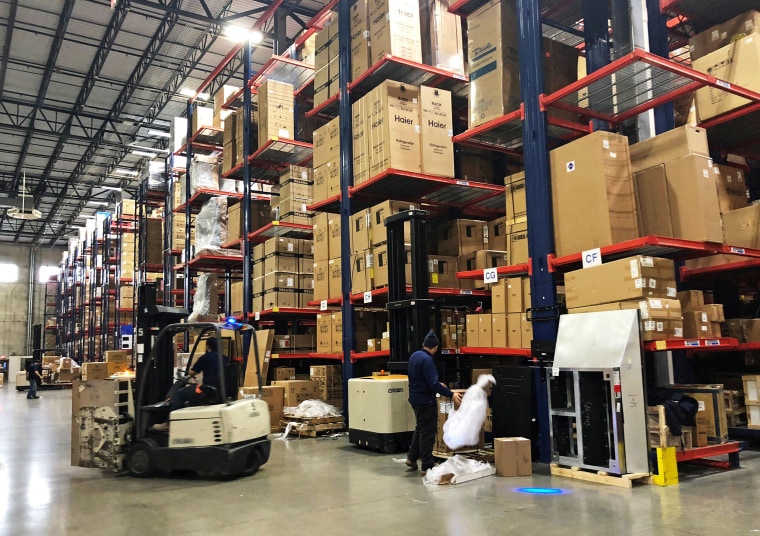In the nearly 40 years she has spent in trade, Amy Magnus has never seen retailers hoarding so much inventory.
Warehouses throughout the United States are at record capacity with Chinese imports of all kinds — microwaves, vacuum cleaner filters, swimwear, furniture — stacked to the ceiling, according to Magnus, who heads the National Customs Brokers & Forwarders Association of America, whose members work with over 250,000 importers and exporters.
"My office is right on a land border and I can see the trucks just coming across non-stop from my window," Magnus said, referring to her birds-eye view from Champlain, New York, of trade on the border between Canada and the United States.
"Even with Christmas, it's been notably busier this week and last week than it's ever been before."
She is one of over a dozen customs brokers, retailers, vendors, analysts and supply chain experts who told Reuters that retailers have been stockpiling inventory from China to avoid higher tariffs that may kick in next year.
The buying binge is also evident in recent data from the National Retail Federation and Hackett Associates, which show imports at major U.S. retail container ports surged 13.6 percent to a record 2.04 million containers in October. This helped push the U.S. trade deficit with China to a record high.
Stores including Walmart, Target, and Macy's raced to buy Chinese products in September, the sources said, the same month President Donald Trump's administration announced 25 percent tariffs would go into effect on Jan. 1 on $200 billion of Chinese imports.
The U.S. and China have since agreed to a 90-day trade war truce until March 2, but supply chain firms and vendors said this has not slowed buying or forward orders because the tariffs could still be hiked.
"We have been tactical and pulled some orders forward," Walmart spokeswoman Marilee McInnis told Reuters. The other major retailers, including Target and Macy's would not comment for this story on the part tariffs played in their approach to buying inventory this year.
The strategy could mean heavy discounts for shoppers next year if retailers are stuck with an overhang of unsold merchandise. Already, it has driven up transportation and warehousing costs, which is adding pressure to quarterly results for retailers, according to the sources.
The question is whether stores absorb the added costs or pass them on to customers.
"More likely than not, the retailer will take them so the consumer doesn't have to," said Jonathan Gold, the NRF's head of Supply Chain and Customs Policy. Gold said he "definitely" expected higher inventory and logistics costs to continue into the first quarter as retailers rush to meet the March 2 deadline. The NRF works with about 18,000 member retailers.
"A lot of people are competing for space right now so you're going to have some retailers hurt as a result."
The surplus signals a stark change from last year, when retailers and department stores were ordering less product and in smaller batches to keep inventory costs down. Retailers have for years been struggling with declining holiday foot traffic, and larger inventories weigh on balance sheets.
"It's very rare that retailers would commit to more inventory in advance," said Neil Saunders, managing director of consultancy GlobalData Retail. "If they don't manage to sell their holiday inventory, we'll see a real glut of it, and some discounting, in the new year."
U.S. vendors and retailers are also boosting inventories to keep up with the strengthening economy, a booming e-commerce market and to get goods in before Chinese New Year. Toy inventories have also been on the rise because Walmart, Target, Amazon and others are aggressively trying to fill the gap left by Toys R Us when it filed for bankruptcy late last year.
Ryan Fry, who has brokered deals between Walmart and domestic and international toy vendors for over six years for Diverse Marketing, said Walmart has bought about 15-20 percent more toys through him since September, compared with last year. Fry said the vendors he works with have all been stockpiling toys from China to get ahead of the tariffs.
"Our merchant teams are working on any kind of eventuality we might face and, as we always do, working with suppliers and how they think about costs," Walmart's McInnis said. "But it can take time to shift production to other regions."
"Retailers are trying to mitigate the tariffs," said Brett Rose, CEO of United National Consumer Suppliers, a wholesale distributor of overstocked goods such as garden tools, beauty products and toys. "Everybody's stocking up. Customers are buying about 20-25 percent more products than last year," he said.
The surge in imports is boosting revenues for U.S. ports and logistics companies, but may mean less business in the second half of next year, some customs brokers said. The Port of Oakland said November imports were up 15 percent from last year and said importers had been rushing in cargo from China ahead of tariffs. Maritime revenue was up 10 percent in the quarter ended September, Port of Oakland spokesman Mike Zampa said.
"If we stay anywhere near this pace, we'll set a volume record for 2018," Zampa said. "Will it last? Well that's obviously the $64 question. I haven't heard anyone say definitely that they know what's going to happen next year."
